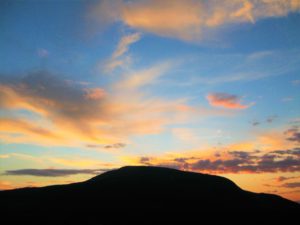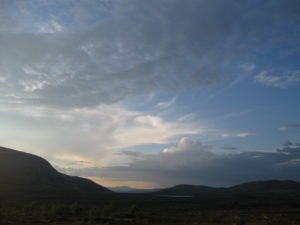The language of stones

Paradise is to be found everywhere. It only depends what you’re looking for. Enchanting forests, endless woods where you walk without encountering another human being – or sunny beaches, fun packed to the maximum. And everything in between. I love nature, the colours, the scents, the seasons. And stones – the small pieces of earth with a history that has such a splendid name: Deep Time.
Home is where the soul has unpacked your suitcase.
Stones and rocks are fascinating. They tell the geological story of the places where we live, hike, eat and rest. A small sized stone is related to its bigger cousins – boulders, mountains, earth plates. A family tree going a long way back, into Earth’s Antiquity. And maybe here I might find the answer to a question that has been on my mind for a long time. Why do I feel at ease and at home in natural surroundings that are rough, almost barren?
Good question. As time passes I see that I am drawn to landscapes with mountains and stones, wind, rain and fog, sea, streams and marsh. Plateaux and tundra. Wetlands without the sheltering presence of woods. But woodlands I love too, so there is more to it.
Tracing back stones to the sea, shells and birds
Home is where the soul has unpacked your suitcase. I wanted to know, to understand, because the places and the landscapes that are drawing you in, reveal something more. It’s about who we are, our character, the meaning we find in nature and in how we relate to it. It comes down to finding and defining one’s own perception of the natural world.
The Nature Lover is not looking for mere facts but for meanings, for something he can translate into terms of his own life. (John Burroughs)
The North Sea
Travelling back in time to childhood years, the salty smell of the sea drifted into the room again. The gently rolling waves in summer and the sea foam, when the sea was agitated by wind and waves. Crowns of white splashes and bubbles, mixed with sea weed, pieces of driftwood, shells of all kind and jellyfish when the wind was coming from the east. Treasures of the sea, collected and cleaned, finding their way to a bookshelf or a small storage box. Hardly imaginable, because I am certainly not a very organized person, that I still have two shells from that North Sea beach.
Great days it were but sometimes we felt sad. Now and then it happened that the birds belonging to the realm of the seas and the oceans, washed ashore. Struggling to free their bodies and wings from the sticky smear, unable to fly. Not fly meant to die, we were well aware of the fact. So we collected as much birds as we could – not easy at all – to take them home. Which was a small and cosy holiday cottage, tucked away in the dunes. The poor victims desperately struggled to escape from our nursing hands, snapping with their beaks, clawing with their feet.
The oil didn’t come off easily and the worst casualties had to be handed over to the local veterinarian, a very helpful man with enormous hands and an ever present smile. Gently he would take the birds from our hands, reassuring the two girls who were standing on his doorstep, tears running down their cheeks, that he would let the sea gulls fly again. We, naturally, believed him. Years after, my father told us they had made arrangements for a special bird care fee, including board and lodging. Parents deserving praise for allowing and helping us in every way they could. The sea, the shells and the sea gulls would be imprinted on my mind from then onwards.
Norway
The sea and the gulls were ever present throughout my youth. We loved the summers and the winters. The foggy days, when the water of the sea was coloured as grey as the sky. The vast landscape of sea and dunes. We travelled a lot abroad as well and some of those holidays were really special. Mostly because we ended up in beautiful surroundings. These were the nature travels, if possible spiced up with some culture. The ideal mix, according to my parents, ought to be 50/50 but they never came close. Nature was in favour by far – with time it resulted in separately scheduled city trips. Best idea ever!
Our Norwegian summer holiday ranked number one, closely followed by destination Scotland. In what is known as the Western Gneiss region of SW Norway, we found fresh wild strawberries, at the muddy banks of the small fjord where we had our holiday home for a month. It was paradise to me. The fjord with its clear and cool water, the summer fruits invitingly hanging on every bush or plant, the endless evenings. Our temporary home was situated on top of giant slabs and blocks of stone, varying in size and shape, overlooking the fjord and surrounded by trees. There were several smaller rocks as well and these were our favourite places to sit, watch, read or just do nothing.
I had my own preferred piece of grey rock. And then something really strange did happen, the first morning after our late arrival the previous day. Walking to ‘my rock’, a sea gull came very near, screaming, flying rounds above my head. After that it just went away in silence. Our days were filled with swimming, fishing, sight-seeing, finding wild strawberries and raspberries and more swimming. Returning to our cabin, there it was, sitting on my rock. The moment I ran outside, eager to find the bird, it came from somewhere, made his rounds, disappeared. At age ten I had my own seagull and this felt fairly special.
Rocks are our friends
If it was for the bird or just curiosity, these encounters (and my waiting for it, mermaid on the stone) was an opportunity to experience those large stones up-close. The most intriguing was their softness – the surface felt like silk. Without knowing anything about their age or history, the appeal was evident. The imprint: stones, strawberries and a seagull.
Geology is poetry
Rocks are our friends. These four words from Haakon Fossen, Professor of Geology (University of Bergen, Norway) express a sensation and fascination. The deeper you go, the more you want to know. It’s the attractiveness of old crust and the underlying transformation and process. Our planet Earth literally comes in layers. Like in a poem – there is so much to read between the lines.
The Caledonian mountain range was formed when the Baltic Shield and the Laurentian Shield collided, about 400 million years ago.
And now for the stones, mountains and the ‘feeling at home’ – it all indicates I’m in relation to the surroundings of the Caledonides. A Deep Time story. To be continued, next episode: Schotland and Sweden. Where the origin of this fascination became clear. A suitcase unpacked.
More
- John Burroughs (1837-1921), the American naturalist, nature essayist and fly fisherman, is best known for his observations on birds, flowers and the rural countryside. Acquainted with, amongst others, Theodore Roosevelt, Thomas Edison, Henry Ford (who came up with an automobile as a present) and John Muir.
- Haakon Fossen website
- General information on the Scandinavian Mountains
- Fjällkedjans bildning och uppbyggnad
Leave a Reply
You must be logged in to post a comment.







